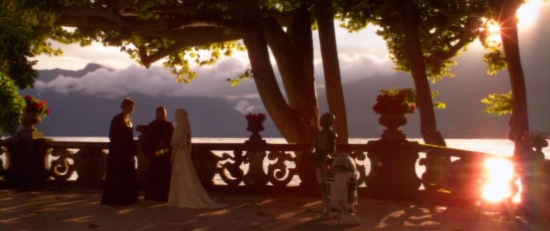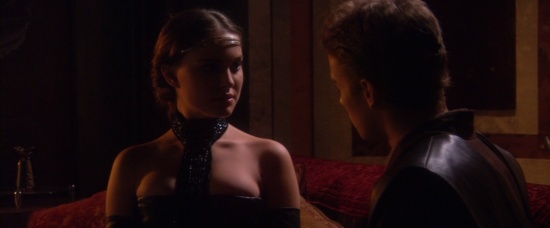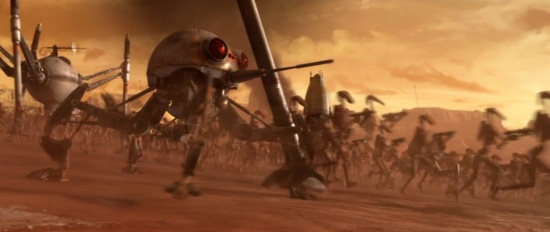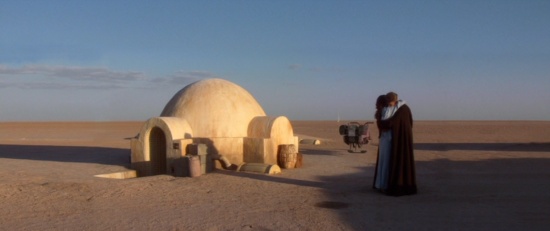Attack of the Clones (George Lucas, 2002)

Part I: All Things Star Wars (The Story So Far)
I’m an unabashed fan of Star Wars… but lately when I say that, it always sounds defensive. I grew up with the original trilogy: while I was too young to enjoy the first two films’ release, they were a video fixture throughout my youth and I remember the excitement of seeing Return of the Jedi in cinemas in 1983. When Lucas re-released the trilogy in hacked-about versions in 1997, my disturbance at his poor creative decisions could not entirely stifle my excitement. As an adult cinema buff, this was my chance to experience the thrill of enjoying Star Wars properly, as a cinema experience. I knew the new trilogy was coming, and that every few years until 2005 I would get a new chance to relive the magic. In 1999, however, The Phantom Menace let me know I was in for a bumpy ride. A film so wretched in so many areas it almost defies any attempt to catalogue its faults (click here for my own attempt written at the time), it was particularly had to take because of the way it seemed to undermine the foundations of the earlier films. Entering the cinema hoping to be reunited with familiar characters, instead I had C-3PO with his skin ripped off. Wanting more quasi-mystical dialogue about Jedi knights sensing the “Force,” I instead was shown Obi-Wan Kenobi doing blood tests for “midi-chlorians” like an intern at the pathology lab.
Of course, I was not alone in my bitter disappointment: the negative reaction to the film was vocal and widespread, to put it mildly. Given that The Phantom Menace followed a sixteen year wait for a new Star Wars film (stoked rather than satisfied by the Special Editions), it was perhaps too easy to write the reception of the film off as an inevitable result of heightened anticipation. Lucas’s inner circle seem to have gone one step further, believing that the film was well received. After all, as producer Rick MacCallum put it, speaking to Empire Online: “You can’t get to $300 million without people actually loving the film and wanting to see it over and over.” Such arrogance probably isn’t helped by some critics’ long-expressed disdain for even the good films in the series: after all, Lucas had to defend the original trilogy against many of the same criticisms made of The Phantom Menace. There have always been those who reacted with hostility, mistrusting the films’ mix of B-film genre conventions and expensive special effects. The films were so easy to enjoy, and so overwhelmingly popular, that they were stigmatised by some as cinematic junk food. Peter Biskind, in his book Easy Riders, Raging Bulls, talks about Star Wars in much the same way that Naomi Klein talks about corporate giants such as Nike or McDonalds in her book No Logo. For Biskind, Star Wars was an all-conquering cinematic juggernaut that dumbed-down the cinema and stifled independent production.
There is truth in Biskind’s argument, although I’d argue that he holds Lucas too accountable for a shift that was caused by much wider economic factors, such as the corporatisation of Hollywood. Yet it is fair to say that there are many flaws in the first three Star Wars films (meaning Episode IV – VI). The first film has a long stretch in the middle (on board the Death Star) that’s outrageously silly. The Empire Strikes Back, probably the strongest of the films, nevertheless slackens in the middle while Luke is with Yoda. Return of the Jedi is particularly weak, with the childish Ewok sequences dragging the whole film down, and an unsatisfying final confrontation between Luke and the Emperor. And all three (particularly Return of the Jedi) have lapses of dialogue and acting, sometimes to the point of embarrassment. So when The Phantom Menace sucked so bad that the theatre doors whistled, it was easy for the nay-sayers to take the criticism a step further and suggest that Star Wars had never warranted praise. All the old criticisms got a new life and even we fans had to ask ourselves if maybe the good things in Star Wars and The Empire Strikes Back were some kind of fluke, or – in our darkest moments – whether our love of the films really was just misplaced nostalgia. (It certainly is true that a majority of Star Wars fans saw the films in their youth.)
Well, dammit, I will fight for the virtues of the original trilogy. Star Wars and The Empire Strikes Back, in particular, I will defend as two of the really great works of fantasy cinema. Given the number of imitations since, it’s easy to forget how bold a film Star Wars was. Working in an (at the time) uncommercial genre, utilising a serial structure that dropped the audience in mid-story, Lucas created a film that was derivative of just about every pulp genre, yet is nevertheless excitingly original and unfamiliar. Seen now, the film is an odd mix of high and low budget filmmaking, where guys in werewolf masks (removed from the Special Edition) are quickly followed by dazzling displays of production value. Like American Graffiti, it manages to be both commercial and experimental at the same time. It is also tremendously exciting, with the final battle being a truly classic sequence. For The Empire Strikes Back, Lucas used stronger writers, and as result added depth to the characters. With a bigger budget, Empire also features more striking imagery, and works up to a finale that delivers at the level of drama, rather than action.
The strength of those two films, and the lure of the words “Star Wars,” were not really diminished by the mediocre but entertaining Return of the Jedi. Yet when Lucas stuffed up with Phantom Menace, it was particularly disappointing. Unlike other notable franchises, such as Bond and Star Trek, Star Wars unfolds within a very rigid framework. So while Bond fans can hold on for the odd short rocky period (such as 1971-1985) safe in the knowledge that more films are to come, each dud Star Wars movie blows a sixth of the saga. That, I think, is why The Phantom Menace inspires such hatred amongst fans. And that is why I was almost fearful in the wait for Attack of the Clones.
Part II: A New Hope?
George Lucas gets a few seconds head start. When that opening catchphrase comes up on the screen, followed by the big yellow writing and John Williams’ blazing score, the pulse races. For those moments, he can do no wrong. No mistakes have yet been made.
Unfortunately, as we know all too well, after that a Star Wars film can go down the drain very quickly indeed. I knew moments into the The Phantom Menace that trouble was afoot (and I don’t just mean the trade blockade of planet Naboo.) So as Attack of the Clones got under way, my nervous anticipation was tinged with real fear. Fear that the first two films of the new trilogy would both be duds, and that my fond memories of the trilogy would be further sullied. Yet two and a half hours later, I walked from the cinema a very happy man. I loved Attack of the Clones.
Having said that, I should note immediately that there are plenty of qualifications to put on that statement. The reviews published on the internet in the week or so before the film opened were widely varied, but split into two broad categories: the hardcore fans, who mostly loved it, and the professional critics, who mostly didn’t. Post-release reviews by fans have been similarly variable, with more of those who saw the film in general release latching onto the kind of criticisms made by media critics. And while I always expected that gradually all those who enjoyed The Phantom Menace on first viewing would turn against it with time, something tells me the divergence of views on this one will remain entrenched. Five years from now, I suspect fans will be as divided over the merits of Attack of the Clones as they are today.
I say that because I loved the film, yet agree with just about every criticism I have heard others make of it. Poor dialogue and acting has been high on the list, and there is no doubt that some of the performances in this film include terrible moments. Lucas often talks about how he employs a theatrical style of acting (rather than Stanislavski / Strasberg-style “method” acting), and argues that critics of his films misunderstand this. Certainly the very formal deliveries used by the Jedi masters in this film are deliberate. Yet Lucas has never been a competent director of actors. He got great performances in American Graffiti, but it seems to have been by showing faith in his cast’s natural abilities: they have commented that Lucas rarely offered any feedback on their acting beyond single word praise (“Terrific!”) when they got it right. I suspect the production methods used on the Star Wars films don’t help: the actors are often doing their job in front of green screens, with their sets to be added later. This can’t help actors to get in the groove, and would compound the problems presented by a non-communicative director. No amount of guff about “theatrical acting” is going to excuse the fact that audiences (including very forgiving opening night audiences) laugh openly at some scenes in the movie. The worst culprits are the love scenes between Anakin (Hayden Christensen) and Padme (Natalie Portman), but there are other such moments scattered throughout. When a character dies in Anakin’s arms, she slumps into death so abruptly and melodramatically that it recalls Bugs Bunny pulling a fake death on Elmer Fudd.

Christensen has been a focus of the criticism, but he does have a certain presence: while his line readings are occasionally stilted, I actually thought he brought an interesting edge to Anakin. It’s really the script that sabotages him. Attack of the Clones is still working off the sins of The Phantom Menace, in that the earlier film wasted a whole installment following around Anakin as a child. This leaves only two films to tell what should be the guts of the story: Anakin’s descent into evil. At script level, this doesn’t leave much room for subtlety, and Christensen is stuck with the thankless task of making Anakin a plausible romantic lead one second and a glowering future servant of evil the next. At a wider level, the film as a whole suffers from such shifting of tone between scenes: the different strands of the plot aren’t juggled with quite the finesse evident in The Empire Strikes Back.
The upside to that sin is that the film is fast, and this is the first of the many positives that redeemed the film for me. Star Wars is supposed to be fun and action-packed, but in The Phantom Menace Lucas got bogged down in exposition: it took an interminable hour to get to the podrace, the film’s first big action set piece. This time, Lucas keeps it moving, and continues to add different types of action to the Star Wars repertoire. This time, for example, we get a down-and-dirty hand to hand fight between Obi Wan Kenobi and Jango Fett, as well as a gladiatorial fight between the three principal heroes and some vicious animated beasts. The latter sequence (which plays out as a tribute to Ray Harryhausen’s stop-motion films) serves as a centrepiece to the film’s very exciting extended finale. Like the original Star Wars, Attack of the Clones manages to overcome a weaker middle stretch by finishing strongly, so that the audience can leave the cinema in a positive frame of mind.
The film also benefits from some having some characters we can relate to. The original trilogy still has the edge on the prequels in that the story essentially followed a group of friends around the galaxy, which – as shallow as those characters may have been – gave some sense of human focus. Attack of the Clones makes a huge step towards returning this feeling to the series by letting Ewan McGregor, as Obi Wan, loosen up and enjoy himself more. McGregor’s really good here. While he has to retain a certain stodginess in his dealings with Anakin, there’s a humour to the character this time that revives fond memories of Han Solo. Similarly, the side-lining of the awful synthetic character Jar Jar Binks allows the welcome return to centre stage of R2-D2 and C-3PO. Back to being the series’ prime comic relief, they have one sequence in particular that made me laugh harder than anything else in Star Wars has. C-3PO is actually funniest when Lucas is really mean to him, as here and in The Empire Strikes Back (truly, he was “made to suffer.”) The villainous side of the ledger is stronger, too, with Christopher Lee’s Count Dooku adding not only Lee’s great screen presence, but also complexity to the plot. (The character is a close reprise of his Saruman character in The Fellowship of the Ring, down to his gift for convincing characters he was on their side).
Yet it’s Lucas’ ability to once again immerse us in this fascinating fantasy universe that really makes the film worthwhile. I still feel the new films are over-produced, in that the CGI has become all-pervasive, and tempts Lucas to overwhelm us with detail (he never fails to show us a crowd of a thousand people when perhaps a dozen would do). The use of computer animation to replicate the existing Yoda puppet also seems a somewhat redundant exercise. Yet the computer technology, in its better moments, does allow him to take us into fascinating and often beautiful new environments. And it’s great to revisit the locales of the series: one of the nicest moments in the film is a visit to the Lars homestead, where we first met Luke at the start of Episode IV. Lucas has obviously gone to enormous effort to reproduce the look of the original sets, and in these moments (importantly, almost free of special effects) there really is a feeling of returning to the world of the original films.
It’s also satisfying to see Lucas starting to pull the loose threads of the story into place. The pleasant surprise of this film is the way he manages to create some unexpected plot twists despite working within the confines of a broad story clearly outlined by the original films. While I still have a feeling that a few points are not going to tie up properly after Episode III – (Did Anakin really tell Obi Wan to give his old lightsaber to Luke? Why does Obi Wan seem so unsurprised to see the droids in Episode IV? And why does Obi Wan imply that Uncle Owen and Anakin knew each other when Anakin left Tatooine, and that Anakin followed Obi Wan out of idealism?) – I have increased faith in Lucas after this installment. An unexpected depth is being added to certain characters, notably Senator Palpatine. While Anakin is fast becoming the most disembodied film character since Blofeld (the role having been shared between five actors all up: Jake Lloyd, Hayden Christensen, James Earl Jones, David Prowse, and Sebastian Shaw), Palpatine has been played by the one actor, Ian McDiarmid*, all the way through. His character, more than any other, will bind the completed six film sequence together.
With all these positives, watching Attack of the Clones is really a wait for Lucas to do something so jarring (or Jar Jar-ing) that it sinks the movie. Clearly, for some viewers, he did so, but for me the false notes weren’t so crucial – the original films had silly moments, after all. It’s just a shame that after getting so much right, he let himself down with about six or seven really awkward scenes. So here’s the plan, George: forget about rehashing the original films, and re-write and re-shoot the scenes in this that don’t work. And that’s just the start. After all, we don’t need Phantom Menace at all, so why not renumber this to Episode I and give us a whole extra film?
The fans will love you for it.
* Barring a brief appearance in The Empire Strikes Back, which one imagines Lucas is going to fix in the inevitable super-special edition re-release of the original trilogy.
Related Items
See all my Star Wars content here.

